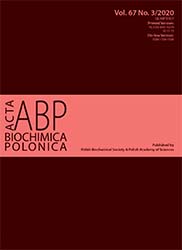Influence of the reporter vector backbone on 2-deoxyglucose dependent promoter activation
Abstract
Reporter vectors are very often used to investigate mechanisms responsible for regulation of promoter activity. Since their first generation, many new variants were constructed to increase sensitivity and reduce background signal. However, these tools are still imperfect and can generate false results. We have found that depending on the backbone of the reporter vector, pGL3 or pGL2, different results are obtained for a eukaryotic promoter’s activation by metabolic changes. These observations were done in the course of investigation of the MMP2 (matrix metalloproteinase-2) promoter regulation in response to inhibition of glycolysis.
Acta Biochimica Polonica is an OpenAccess quarterly and publishes four issues a year. All contents are distributed under the Creative Commons Attribution-ShareAlike 4.0 International (CC BY 4.0) license. Everybody may use the content following terms: Attribution — You must give appropriate credit, provide a link to the license, and indicate if changes were made. You may do so in any reasonable manner, but not in any way that suggests the licensor endorses you or your use.
Copyright for all published papers © stays with the authors.
Copyright for the journal: © Polish Biochemical Society.


